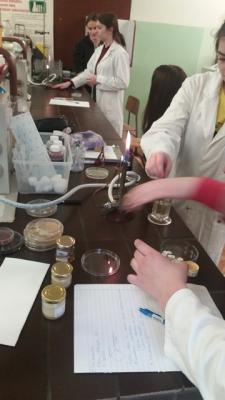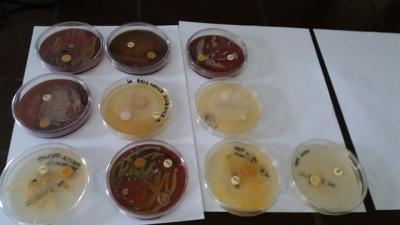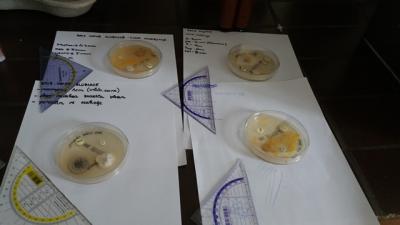Samstag, 21. April 2018
The effectiveness of bee products on bacteria
beekids, 23:56h
We've decided to do a research on how affective honey and other bee products are against bacteria and if it's comparable to antibiotics. With the survey we checked which bee products are most common in our diet. We've done a lot of agar diffusion tests and microbiological investigations in our school's lab and researched a lot of examples under microscopes. We've found out that honeys and products that origin from places around us are actually more effective than those who aren't. But the product that was effective on all of our samples was royal jelly which was predictable since royal jelly is quite well known for it's characteristic. Unfortunately, royal jelly is less known and used among the students . It is delightful that most people use honey in their daily diet.
The disk diffusion agar method tests the effectiveness of antibiotics on a specific microorganism. An agar plate is first spread with bacteria, then paper disks of antibiotics are added. The bacteria is allowed to grow on the agar media, and then observed. The amount of space around every antibiotic plate indicates the lethality of that antibiotic on the bacteria in question.

And how we made disk diffusion agar method test?
1. Using an aseptic technique, place a sterile swab into the broth culture of a specific organism and then gently remove the excess liquid by gently pressing or rotating the swab against the inside of the tube.
2. Using the swab, streak the Mueller-Hinton agar plate to form a bacterial lawn.
• To obtain uniform growth, streak the plate with the swab in one direction, rotate the plate 90° and streak the plate again in that direction.
• Repeat this rotation 3 times.
3. Allow the plate to dry for approximately 5 minutes.
4. Use disc without antibiotic and soak them in one of the bee products.
5. Using a flame-sterilized forceps, gently press each disc to the agar to ensure that the disc is attached to the agar.
6. Plates should be incubated 24 h at an incubation temperature of 37 °C (98.6 °F).



A: The swab of a the throat - human
B: The swab of the oral cavity of the cats
C: The swab of tonsils - human
D: The swab of the throat - human
E: The swab of the throat - human
F: Mastitis cysts in cattle
G: The pustules - human
H: The swab of the the gums - cat
I: The swab of the throat - human
J: The swab of the gums - dog
K: Abscesss - sheep
L: The swab of inflamed joint - goose
M: The swab of inflammated eye conjuctica - cat

The disk diffusion agar method tests the effectiveness of antibiotics on a specific microorganism. An agar plate is first spread with bacteria, then paper disks of antibiotics are added. The bacteria is allowed to grow on the agar media, and then observed. The amount of space around every antibiotic plate indicates the lethality of that antibiotic on the bacteria in question.

And how we made disk diffusion agar method test?
1. Using an aseptic technique, place a sterile swab into the broth culture of a specific organism and then gently remove the excess liquid by gently pressing or rotating the swab against the inside of the tube.
2. Using the swab, streak the Mueller-Hinton agar plate to form a bacterial lawn.
• To obtain uniform growth, streak the plate with the swab in one direction, rotate the plate 90° and streak the plate again in that direction.
• Repeat this rotation 3 times.
3. Allow the plate to dry for approximately 5 minutes.
4. Use disc without antibiotic and soak them in one of the bee products.
5. Using a flame-sterilized forceps, gently press each disc to the agar to ensure that the disc is attached to the agar.
6. Plates should be incubated 24 h at an incubation temperature of 37 °C (98.6 °F).



A: The swab of a the throat - human
B: The swab of the oral cavity of the cats
C: The swab of tonsils - human
D: The swab of the throat - human
E: The swab of the throat - human
F: Mastitis cysts in cattle
G: The pustules - human
H: The swab of the the gums - cat
I: The swab of the throat - human
J: The swab of the gums - dog
K: Abscesss - sheep
L: The swab of inflamed joint - goose
M: The swab of inflammated eye conjuctica - cat

... comment